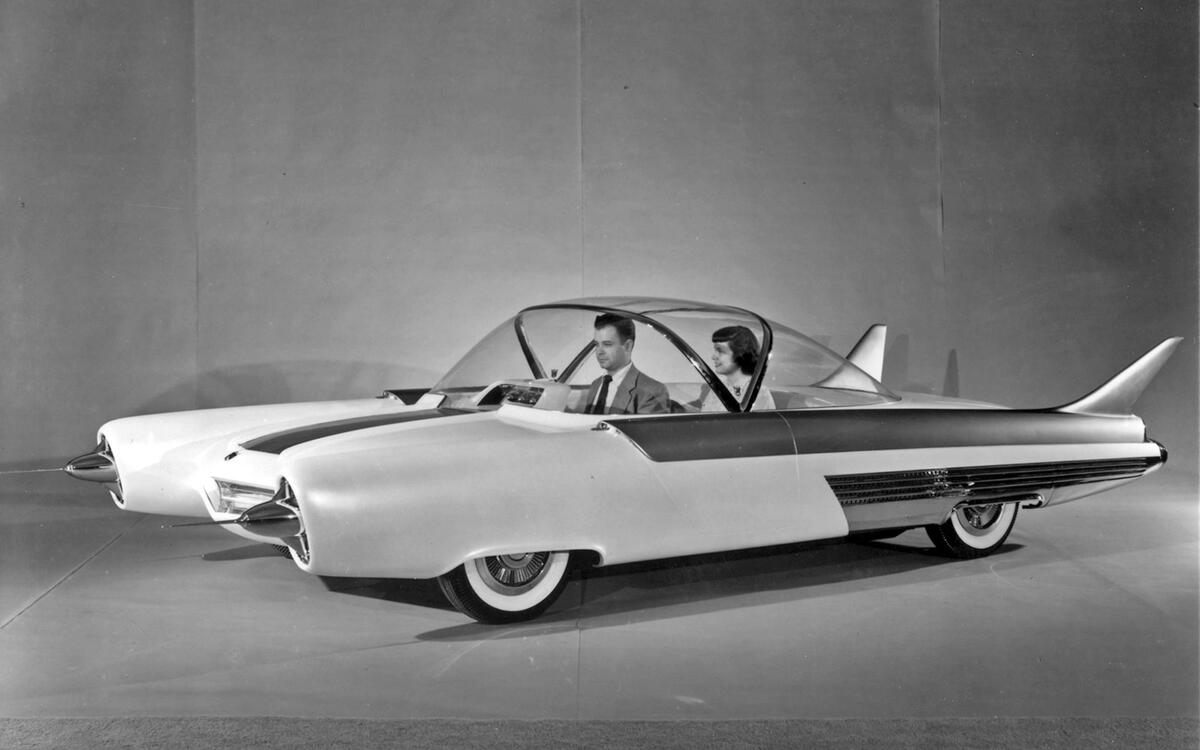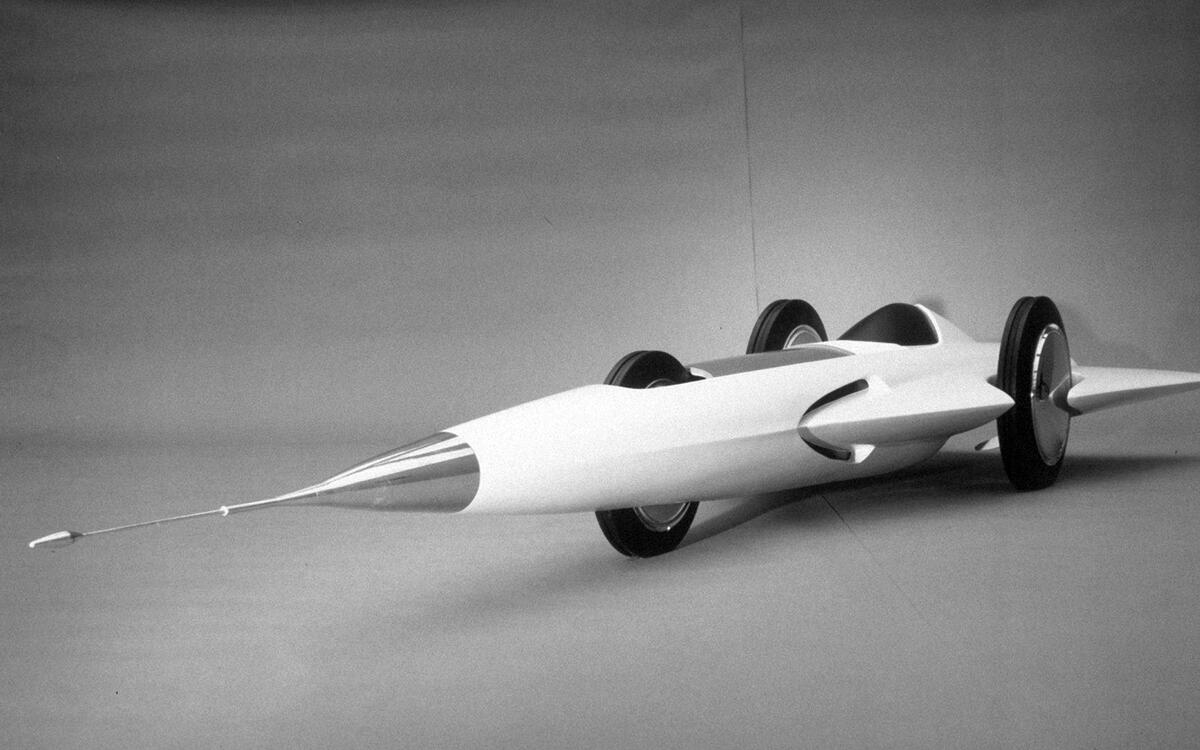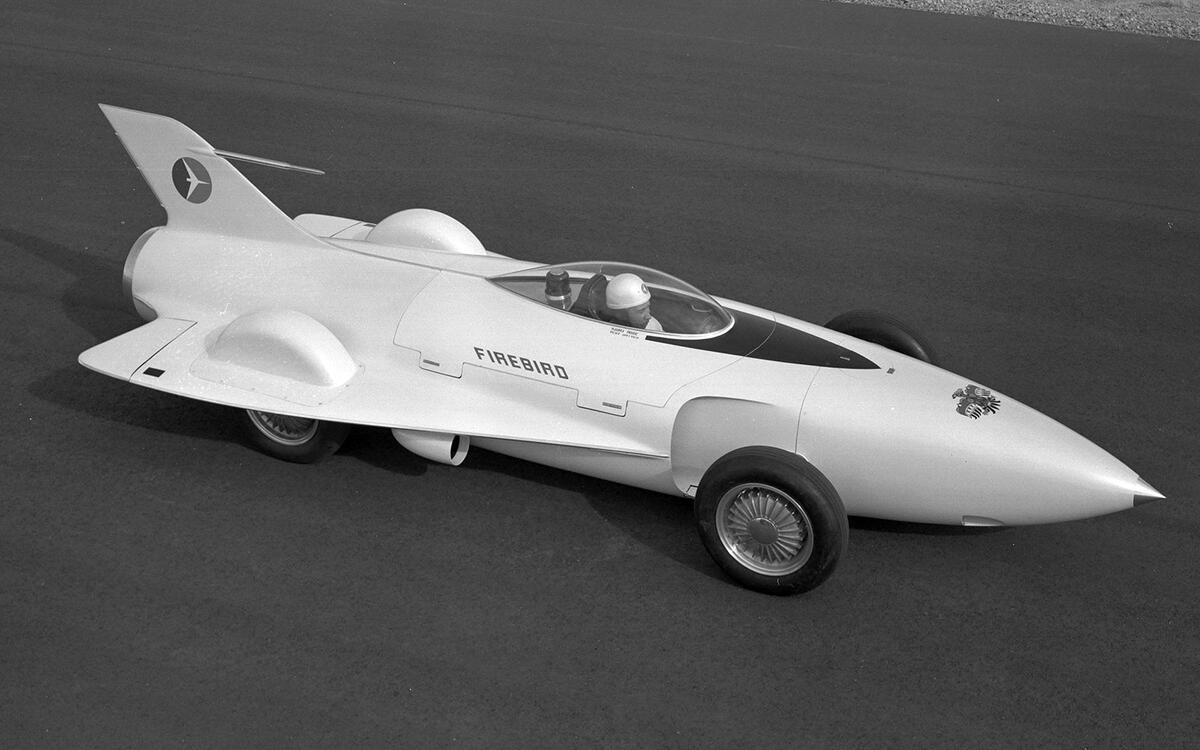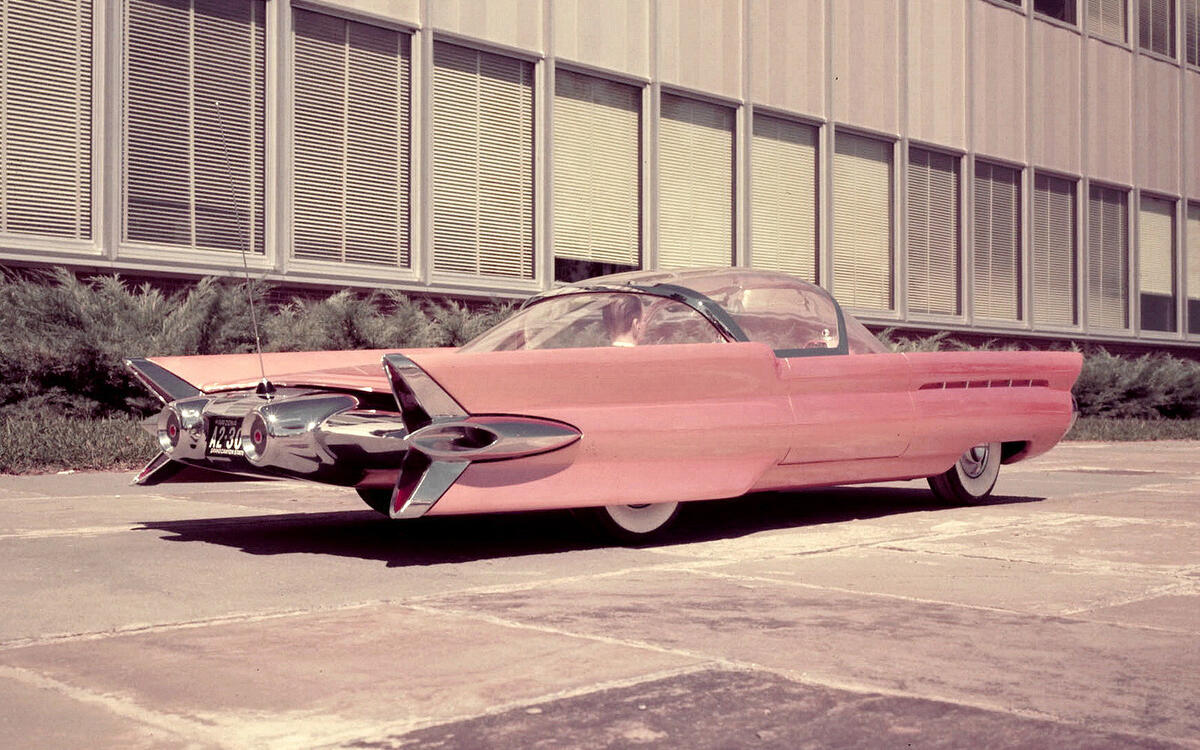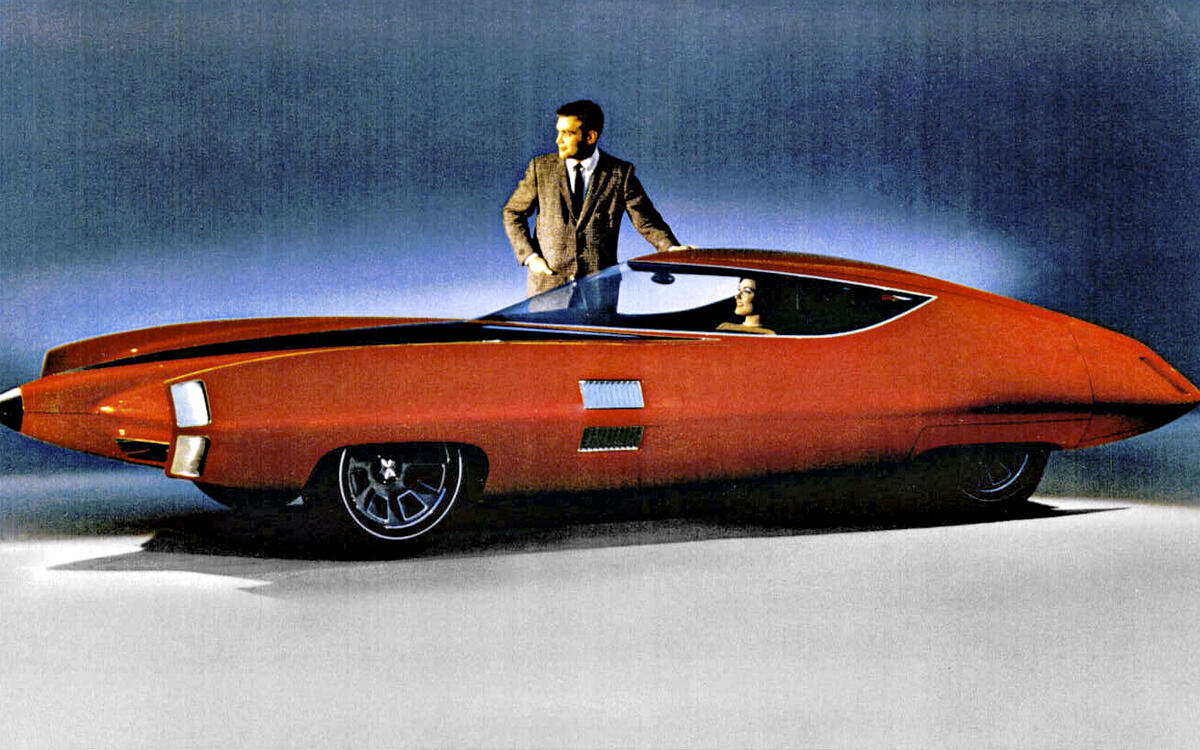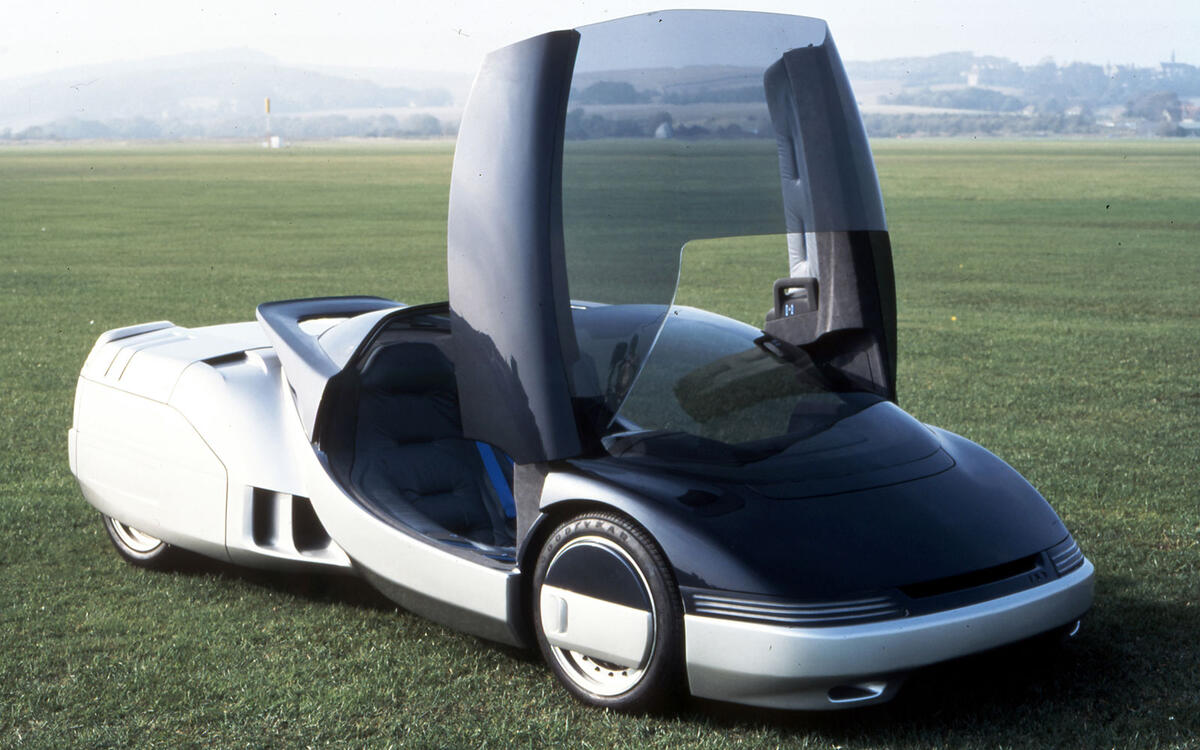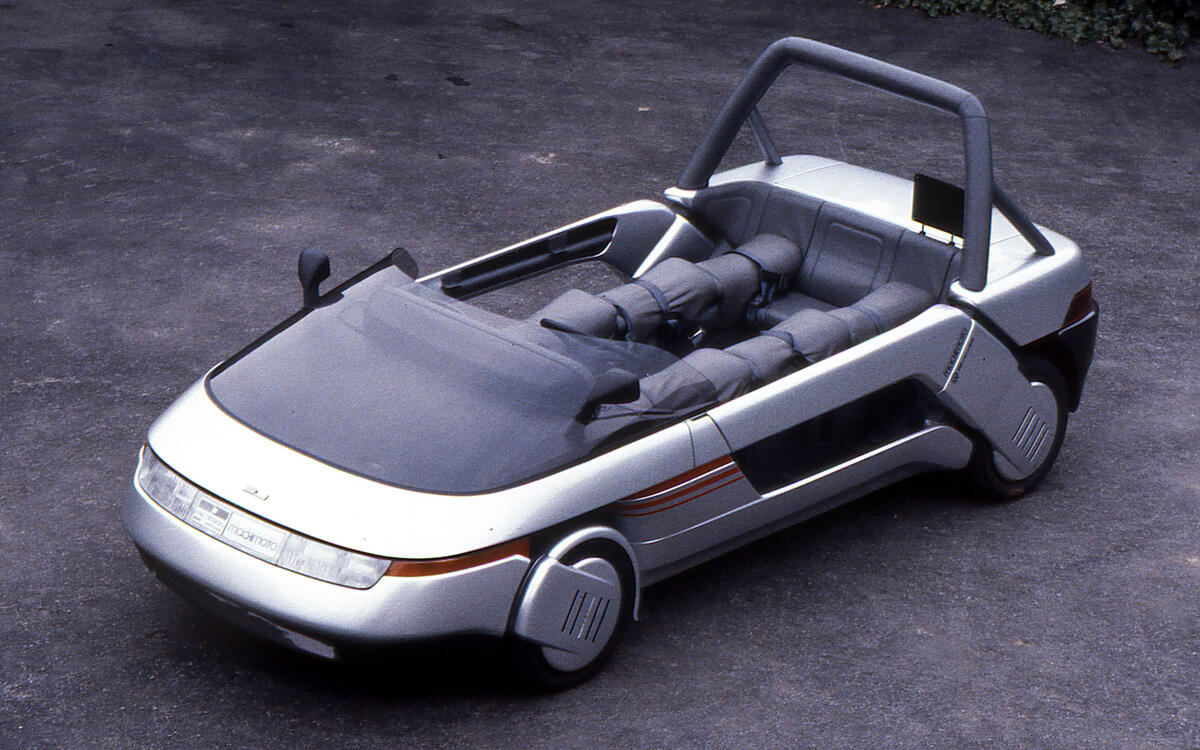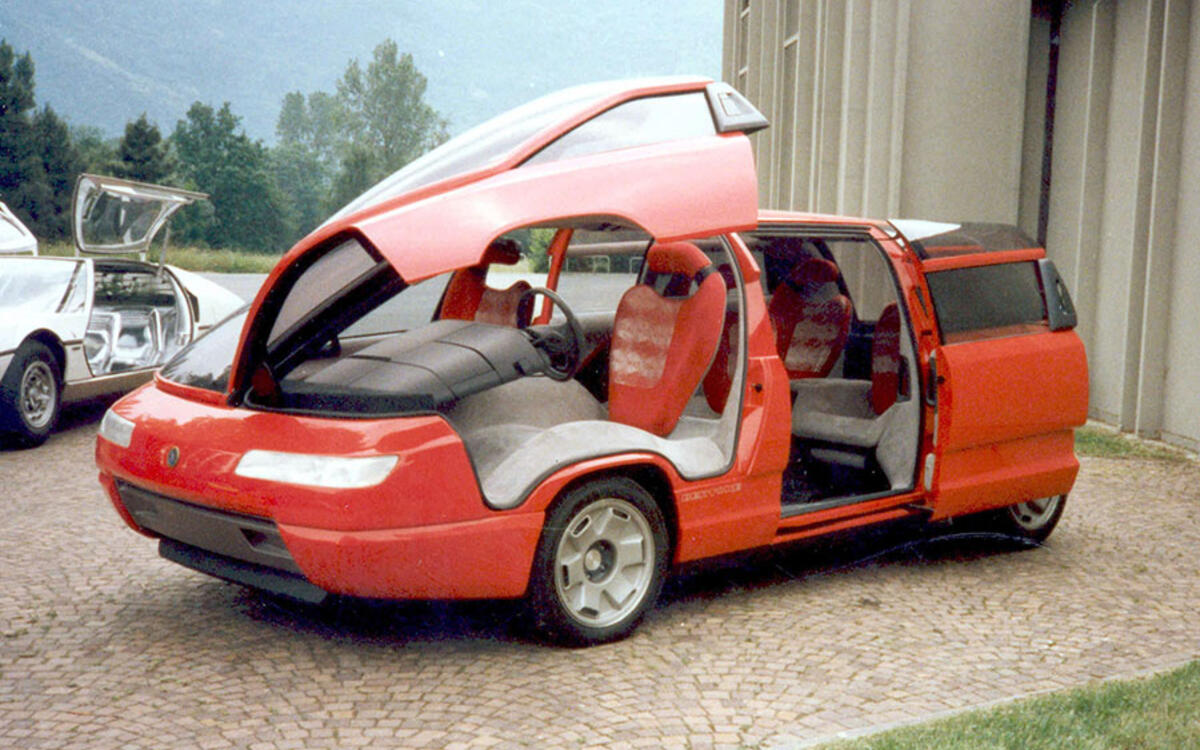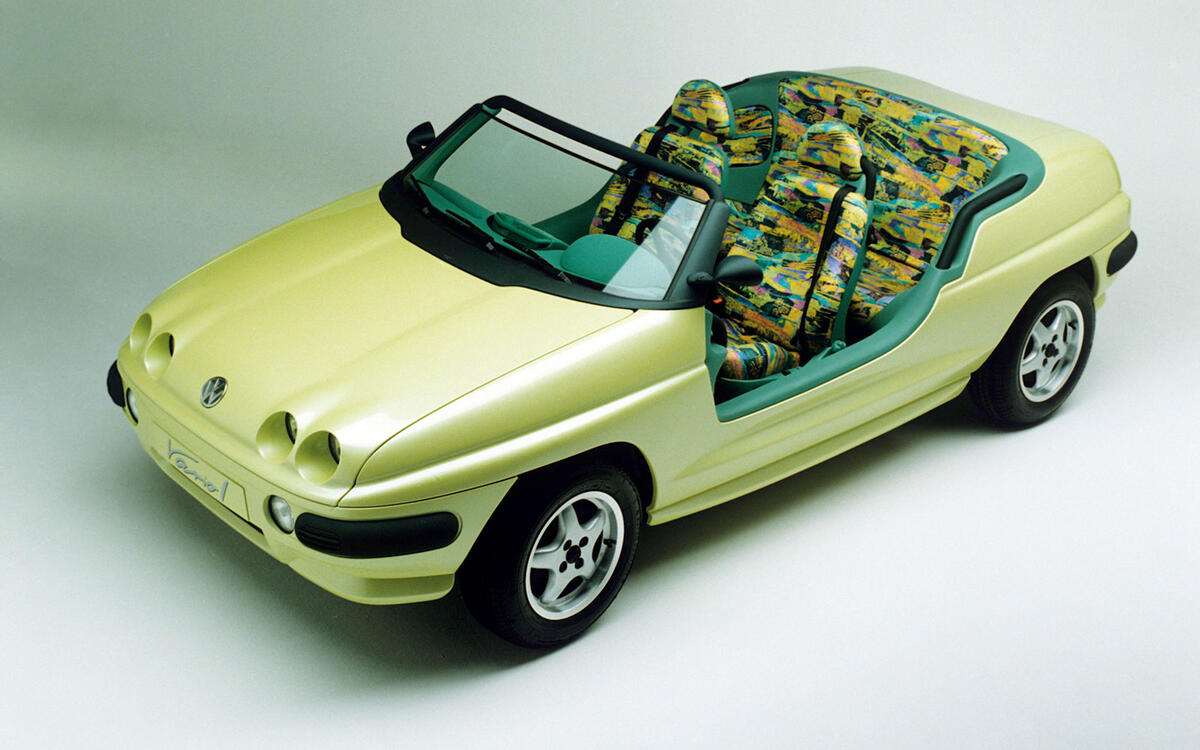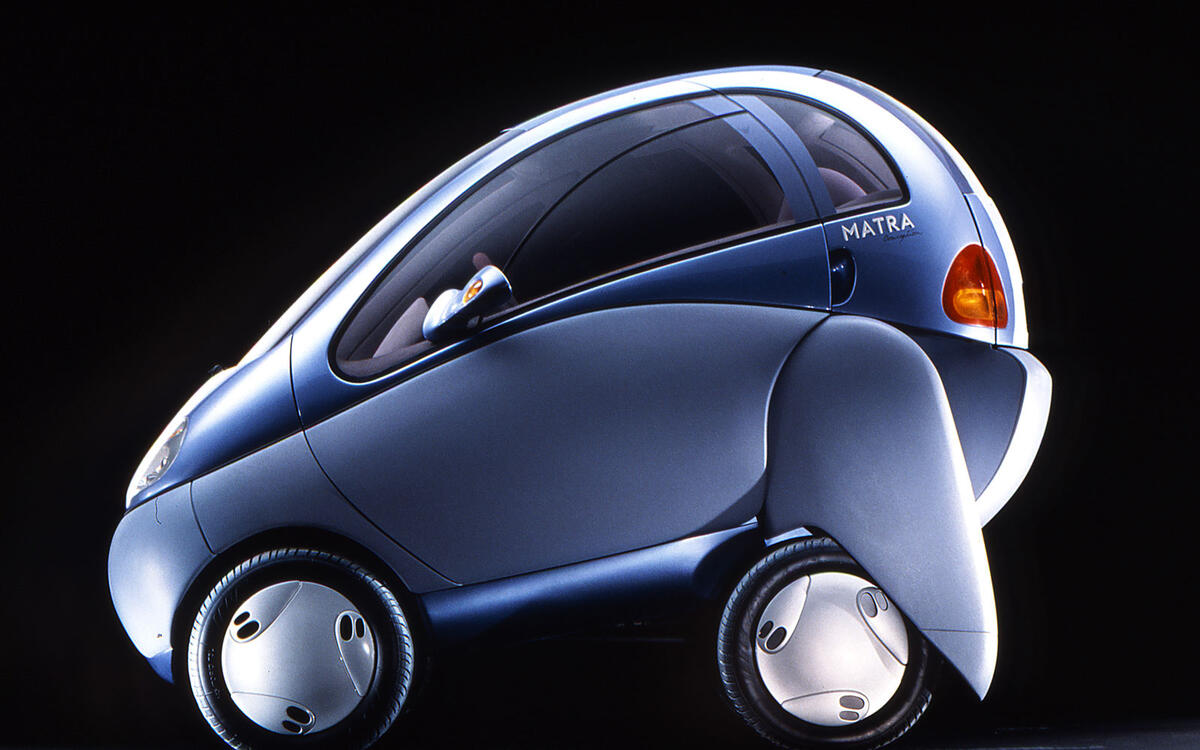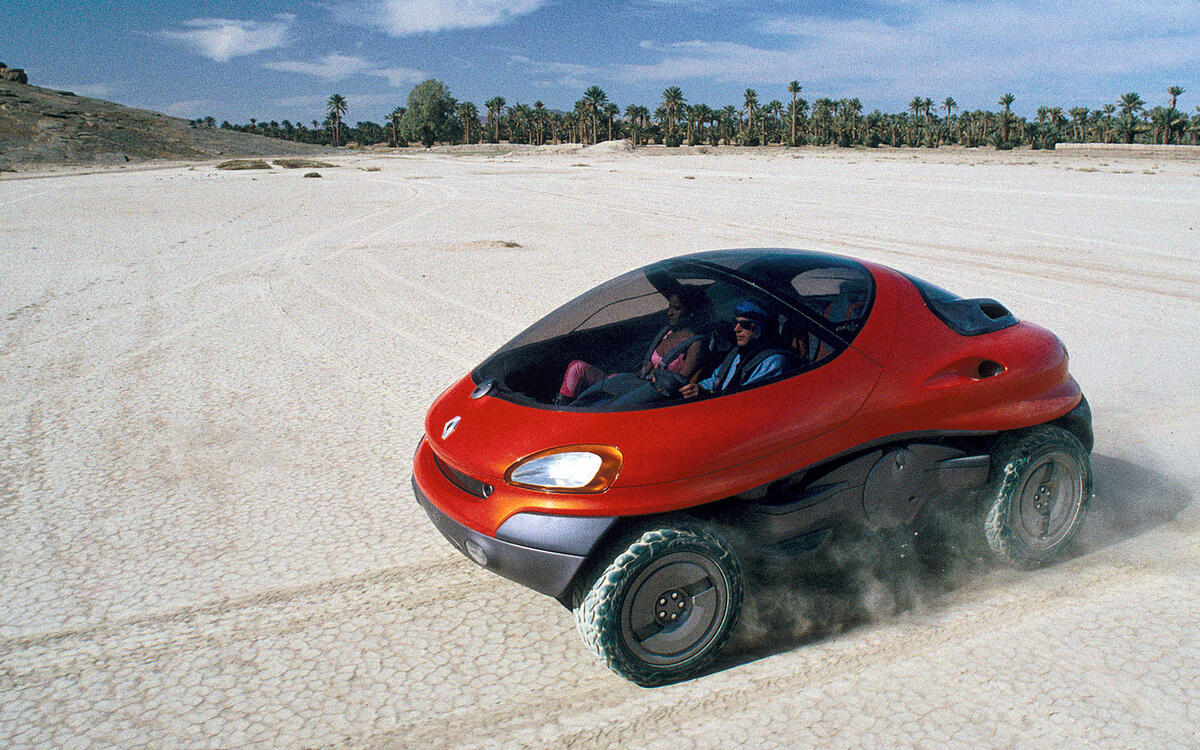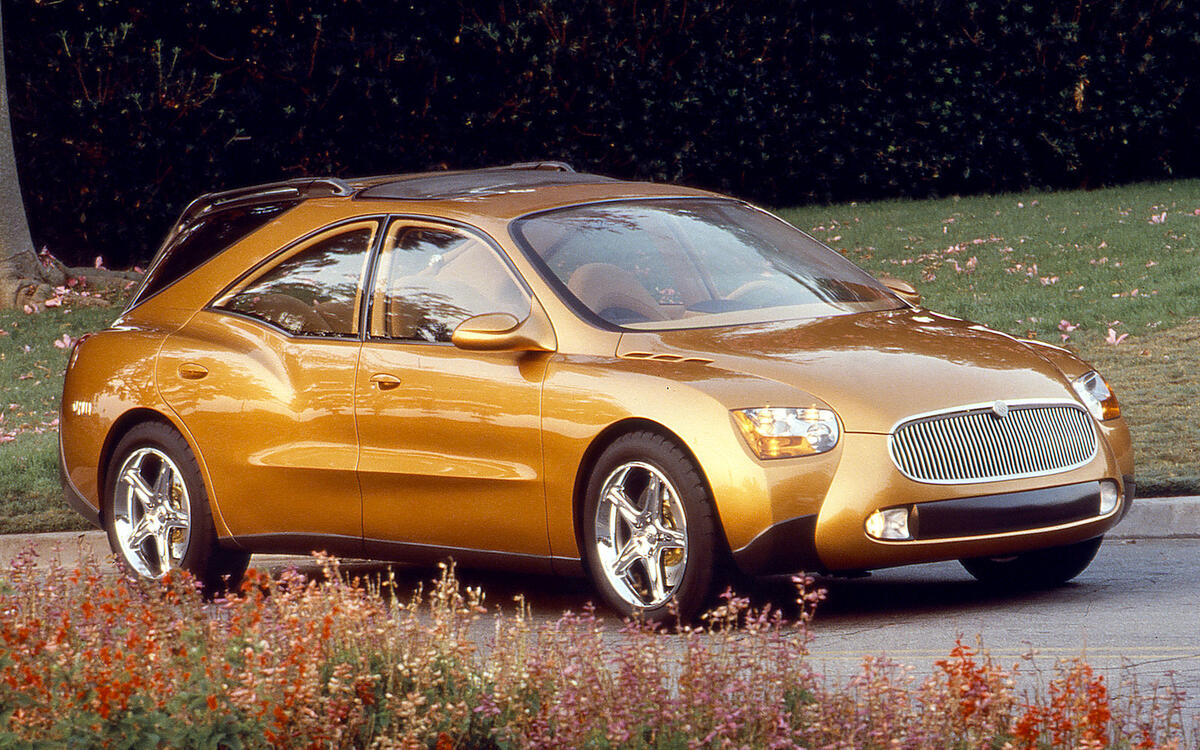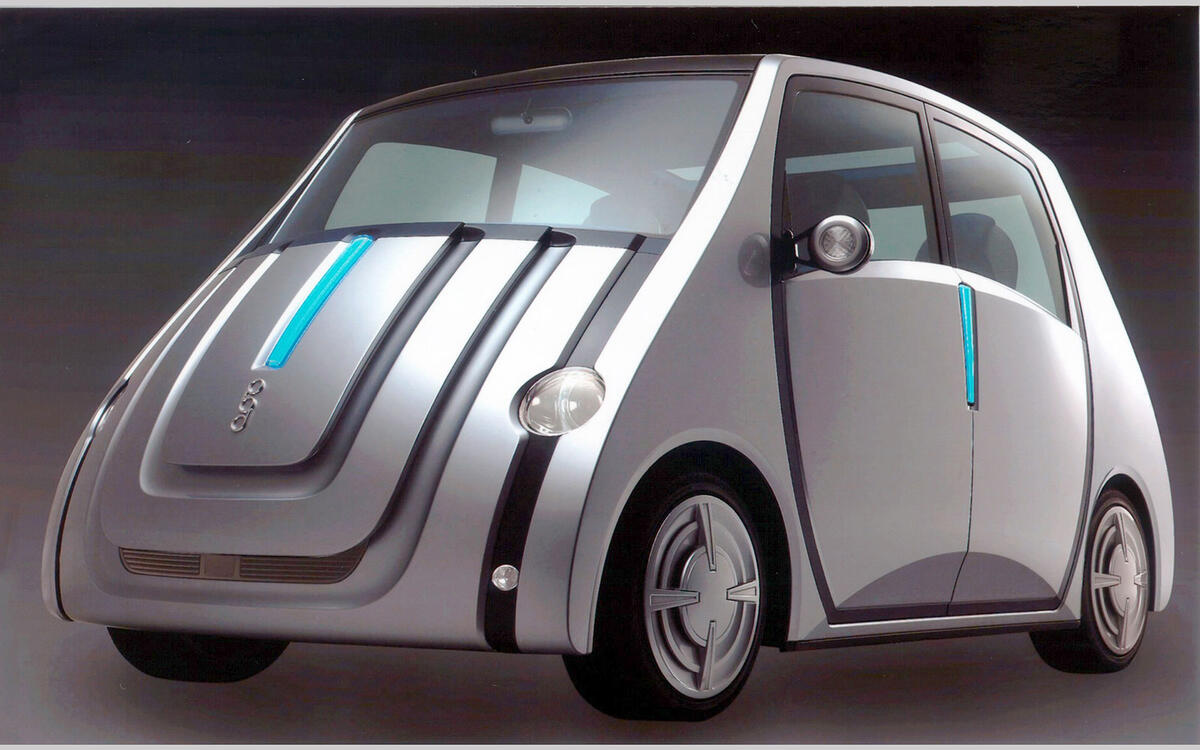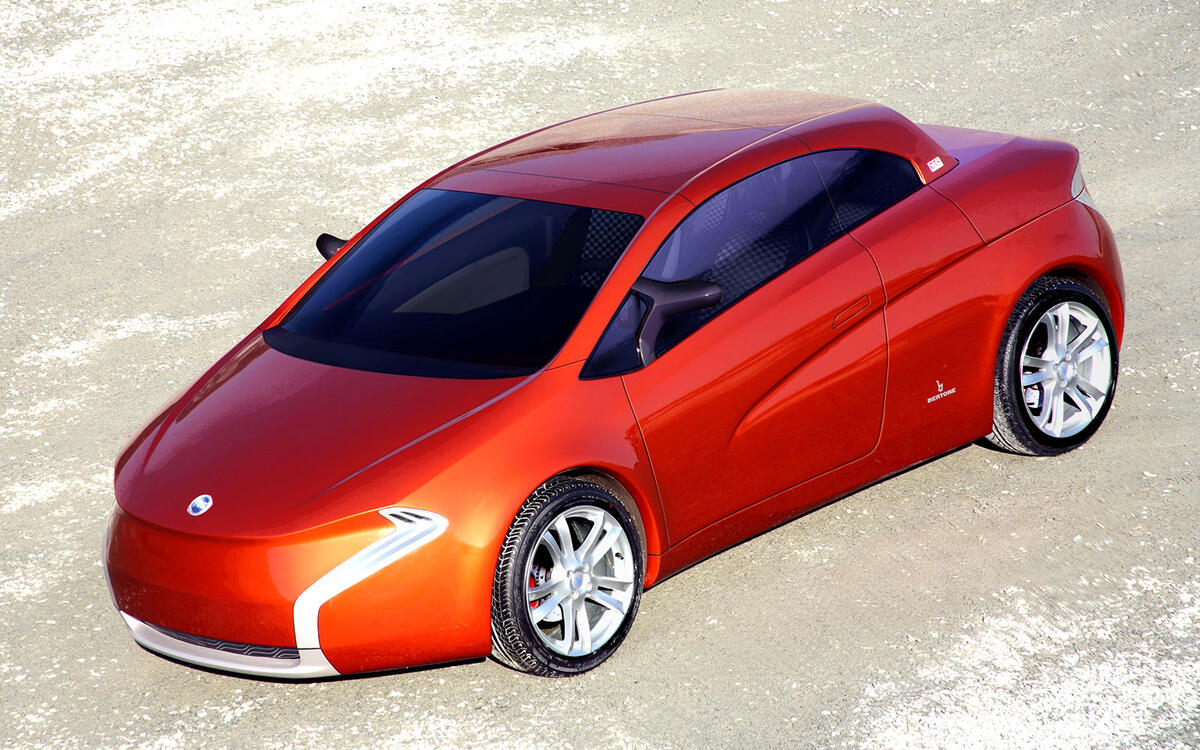 Slide of
Slide of
Ever since the first 'dream cars' were created in the 1930s, designers and engineers have tried to look into the future.
They built prototypes and design studies to show what might be possible one day. New propulsion systems, electronic driver and safety aids, plus advances in exterior design have transformed production cars over more than a century.
But take a look at some of these crackpot concepts and you could be forgiven for wondering why the pace of change has been so slow. Or being thankful that most of these crazy creations never reached showrooms. Enjoy the trip:
 Slide of
Slide of
Volvo Venus Bilo (1933)
This car was so radical when it was first shown, the company behind it refused to be linked to it. In an era where full-width styling was very much in the future, the Venus Bilo embraced it, but it wasn’t until years later that Volvo admitted it had bankrolled the project.
 Slide of
Slide of
Chrysler Thunderbolt (1940)
The Chrysler Thunderbolt wasn't a small car, but it could seat just two people as its retractable hard top was stowed behind the cabin – then behind that was the luggage bay. Nick-named "the Push-Button Car", the Thunderbolt's roof, windows and retractable headlights were all electrically controlled. Six Thunderbolts were made, all trimmed differently, for displays across the US.
 Slide of
Slide of
Fiat Turbina (1954)
Admittedly this was more of a prototype than a concept – but what an incredible design! Fiat started to develop a gas turbine engine for automotive use as early as 1948. Using a Fiat 8V chassis, the Turbina was honed in the wind tunnel and the result was a drag co-efficient of just 0.14. Fiat wasn't the only car maker to build a vehicle powered by a gas turbine engine – and just like all the others it realised the technology was never going to work.
 Slide of
Slide of
Ford FX Atmos (1954)
The FX stood for Future Experimental, those spears on the front were aerials to help control the car to stop it running into vehicles in front, and the ‘Atmos’ was taken from atmosphere, which Ford said “came from free and unlimited creative thinking”. With a glass canopy, seating for three and a pair of aircraft-style fins, this was truly a jet-age design.
 Slide of
Slide of
Ford Maxima (1954)
Dreamed up by Alex Tremulis (1914-91), the three-wheeled Maxima was a rocket car designed to be propelled by a jet engine at speeds of up to 500mph. Way too radical to inspire any road cars, Craig Breedlove's Spirit of America land speed record car did take some of its styling cues from the Maxima.
 Slide of
Slide of
GM Firebird I (1954)
The first of three Firebird concepts, this one featured a single-stick control system which dispensed with the steering wheel, accelerator and brake. Because it was located in the middle of the car either the driver or passenger could operate it; power came from a gas turbine which could be used to power a house via a built-in generator.
 Slide of
Slide of
Ford La Tosca (1955)
Capable of being driven via remote control from up to a mile away, the Ford La Tosca was designed by Alex Tremulis, who had also penned the Tucker 48 'Torpedo'. Featuring fins at the front as well as the rear, the La Tosca was a typical jet age concept with its Plexiglass dome over the cabin.
 Slide of
Slide of
Dodge Dart (1956)
Created in the wind tunnel, the Dodge Dart was the world's most aerodynamic car when it was unveiled in 1956. Dodge claimed that the Dart had less than one third of the drag of the most aerodynamic production cars of the time. Capable of seating four, the Dart's steel roof could be kept in place or retracted into a concealed compartment behind the rear seat.
 Slide of
Slide of
Oldsmobile Golden Rocket (1956)
Nobody could keep up with the Americans in the 1950s, with one space-age creation appearing after another. The Golden Rocket packed a 275bhp punch from its 3.2-litre V8, and it introduced us to powered steering column adjustment. Its party piece was the way the seats rose up and swivelled outwards when the doors were opened – and at the same time, the roof panels hinged upwards so it was easier to get in and out.
 Slide of
Slide of
Chrysler Imperial d'Elegance (1958)
From the A-pillar back the Imperial d'Elegance wasn't quite so radical; many of the features would appear on production cars very soon after this concept was unveiled in 1958. But that nose would always be controversial with its vestigial bumpers, full-width grille and concealed headlights.
 Slide of
Slide of
Ford DePaolo (1958)
The Ford DePaolo was named after Indy 500 racer Peter DePaolo (1898-1980), who had enjoyed success in the 1930s. Designed by Buzz Grisinger (1908-2002), the DePaolo was intended to be a key exhibit in Ford's Stylerama project – dreamed up to compete with GM's Motorama which toured the US in the 1950s. But Stylerama was canned before it ever reached fruition, and with it went the DePaolo.
 Slide of
Slide of
Ford Levacar Mach 1 (1958)
Think of the Ford Levacar Mach 1 as an ancestor to the Renault Twizy – or is it a successor, way in the future? Either way, the single-seater Levacar was supposed to float along on a cushion of air, gliding a few inches off the ground. Intended to be powered by a turbojet engine, the top speed was supposed to be around 500mph. Which would have been hair-raising on a dedicated race track, never mind the public road.
 Slide of
Slide of
Ford Volante (1958)
The imaginations of Ford's designers were particularly fertile when they came up with this one – a hover car that was propelled by three engines in triangular formation. These gave the Volante lift as well as thrust, but as the picture shows – this is one that never got off the ground as it was just a scale model.
 Slide of
Slide of
Plymouth Cabana (1958)
In some ways this doesn't look that dissimilar from some of the cars that were on American roads in the early 1960s, but that roof treatment is pretty wild with its huge three-dimensional rear window, fins and sharply sloping windowline. If the Plymouth Cabana seems to be multiple cars in one that's because it was; the brief was to come up with a four-door hard-top station wagon and an ambulance or hearse conversion in one vehicle.
 Slide of
Slide of
Cadillac Cyclone (1959)
Few cars can make the iconic 1959 Cadillac appear low-key, but the Cyclone of the same year gave it a pretty good go. Those black cones in the nose were equipped with radar to help the Cyclone’s driver avoid anything in the way, while the cockpit was protected by a single-piece plastic canopy coated with vapourised silver to deflect the sun’s rays.
 Slide of
Slide of
De Soto Cella (1959)
Another one that never got beyond the scale model stage, the Cella from Chrysler looked futuristic enough, but it was the propulsion system that was out of this world. Instead of using a conventional engine, the Cella was powered by an electrochemical system that was supposed to transform hydrogen and oxygen into silent electrical energy to drive lightweight motors fitted to each wheel.
 Slide of
Slide of
Pininfarina X (1960)
We're struggling to work out what the benefits are of a rhomboidal wheel layout – that is one up front, one at the rear and two in the middle. Mounted over one of the central wheels was a Fiat 1100 engine and by honing the aerodynamics (the CD was just 0.2) the Pininfarina X could travel swiftly and frugally. But whichever way you looked at it this was one hideous concept.
 Slide of
Slide of
Plymouth XNR (1960)
Asymmetrical in the same way as a Jaguar D-Type, with its off-centre fairing, the Plymouth XNR could seat two, but with a tonneau over the passenger seat it was generally set up for just a driver. Power came from a 2.8-litre straight-six rated at 250bhp.
 Slide of
Slide of
Dodge Flitewing (1961)
Concepts have a habit of answering questions that nobody ever asked, and in the case of the Dodge Flitewing it was about improving access to a generously proportioned two-door saloon. Dodge tackled this by incorporating flip-up panels into the roof, so the Flitewing had a combination of gull-wing and conventional doors. Naturally everything was controlled electrically, via push buttons.
 Slide of
Slide of
Ford Gyron (1961)
You could be forgiven for thinking that the Gyron was a three-wheeler, but as the name suggests it actually had just two wheels. To aid stability there was a stabiliser on either side of the rear wheel to keep the Gyron upright when stationary or while getting up to speed.
 Slide of
Slide of
Ford Cougar 406 (1962)
Someone at Ford had clearly spent a lot of time lusting after the Mercedes 300SL Gullwing, resulting in this concept featuring exactly the same door treatment. Unveiled at the 1962 Chicago Auto Show, the Cougar 406's doors popped open and shut electrically, while power came from a 406 cubic-inch (6650cc) V8.
 Slide of
Slide of
GM X Stiletto (1964)
Someone was clearly putting the boot in when they issued the brief for this one; a super-slippery sports car called the Stiletto. With its climate-controlled cabin, variable-ratio steering via electric motors, a rear-view camera and ultrasonic sensors around the car it was certainly prophetic, but we wouldn't fancy having to foot the bill to replace that expansive windshield when it got hit by a stone.
 Slide of
Slide of
Dodge Deora (1965)
Based on a 1965 Dodge A100 pick-up truck, the Deora was created for the 1967 Detroit Autorama. Chopped and sliced to the nth degree, the Deora's windscreen was the rear window of a 1960 Ford station wagon, the 2.8-litre straight-six engine was moved forward 15 inches, and the vehicle was painted in metalflake gold.
 Slide of
Slide of
OSI Silver Fox (1967)
There's radical and then there's this. In a bid to create a super-slippery shape, OSI came up with a car that featured twin pontoons, with the engine mounted behind the passenger. Aerodynamically the car was a success as its CD was just 0.26, but for some reason the design didn't catch on when it came to production cars.
 Slide of
Slide of
Autobianchi Runabout (1969)
Ironically, while the Runabout was never intended to ever go into production, its basic design formed the basis of the Fiat X1/9. Conceived purely as a fun car, the Runabout was powered by a mid-mounted Autobianchi A112 engine, there was no weather protection, the only instrument on the dash was a compass and the headlights were mounted above the two occupants' heads. Unsurprisingly, quite a few changes were made to turn the Runabout into the X1/9.
 Slide of
Slide of
Plymouth Duster I (1969)
If you're creating a high-speed racer and aerodynamics are crucial, a slippery shape would be a good starting point. but when Plymouth created the Duster it lopped the roof off a Road Runner, fitted an aeroscreen, then plastered the bodywork with adjustable flaps to control lift and drag. There were two in the front wings, two in the rear and another pair in the hoop spoiler above the cockpit.
 Slide of
Slide of
Buick Century Cruiser (1969)
Designed originally as the Firebird IV in 1964, this high-performance car was designed as an autonomous vehicle with all of the comforts of a living room. As such the seats could recline and swivel, there was a TV and pull-out table and even a built-in fridge. Looking at the picture it’s hard to see how they fitted that lot in; it must have been very cosy inside...
 Slide of
Slide of
Chevrolet Astro III (1969)
If you’re starting with a clean sheet to design a car, the obvious thing to do is to get the wheel layout spot on, not just close. Nobody told GM's designers though; they put the Astro III's two front wheels next to each other so it looked like a three-wheeler, massively compromising stability.
 Slide of
Slide of
Chrysler Concept 70X (1969)
This sleek-looking beast wasn't that far removed from a contemporary production vehicle if you imagined it with conventional doors – but instead they popped out then slid forwards or backwards to allow entry and exit. It's a system that's never caught on (funny that…), although proximity sensors have done so, albeit only recently. The Concept 70X's sensors fed a series of lights on the rear-view mirror, warning of traffic approaching from behind.
 Slide of
Slide of
Lancia Stratos Zero (1970)
The seventies was the decade of The Wedge and this was one of the wedgiest concepts ever dreamed up. It was also one of the lowest at just 83cm. Another Marcello Gandini (born 1938) confection, the Stratos Zero featured a 115bhp 1.6-litre V4 from the Lancia Fulvia. Talk about all mouth and no trousers.
 Slide of
Slide of
Mazda EX-005 (1970)
Proposed specifically as an urban commuter car, the EX-005 offered seating for four, but little in the way of comfort as those seats were of moulded plastic. The weather protection was also pitiful and as far as crash safety was concerned, forget it. However, the rotary/electric hybrid powertrain was far-sighted, if something of a dead end.
 Slide of
Slide of
Toyota CX-80 (1979)
Car makers often set out with good intentions to create a car that genuinely moves things on – then they naff it all up by coming up with a design so unspeakably awful that nobody could ever take it seriously. The CX-80 was just such a car; it was intended to offer ample space for a family of four, while taking up less road space than Toyota’s smallest production model, the Starlet. So it’s a shame it looked as though the CX-80 had been designed by a five-year old.
 Slide of
Slide of
Citroën Karin (1980)
The Citroën Karin was the work of Trevor Fiore (born 1937), who presumably had overdosed on Toblerone at the point that he penned this rather triangular concept. With a central driving position, the driver was flanked by a passenger on either side and behind, McLaren F1-style.
 Slide of
Slide of
Mercury Antser (1980)
Another car with weird doors for the sake of it. In fact they look as though they cause more problems than they solve, as once open they'd just get in the way. More impressive was the electronic dashboard which incoprated a (non-functioning) navigation system that allowed traffic jams to be avoided.
 Slide of
Slide of
Zagato Chicane (1983)
Looking like a cross between a Subaru XT and the IAD Alien (the latter is coming up very soon…), the Chicane featured a chassis onto which pretty much any body configuration could be fitted. The 2.0-litre engine could be mounted in the middle or the rear but as with so many Zagato designs, the Chicane failed to look appealing.
 Slide of
Slide of
Peugeot Quasar (1984)
Just a few months after Peugeot put its ultra-affordable 205 on sale, the French company unveiled this – an extreme supercar with a 600bhp turbocharged four-cylinder engine. There was four-wheel drive (all visible from the rear) and the cabin featured "dichroic transflective liquid crystals" for the instrumentation, while a CRT (Cathode Ray Tube) displayed warning messages, maps and telex messages – remember those?
 Slide of
Slide of
Sbarro Challenge (1985)
You can always rely on Franco Sbarro (born 1939) to come up with something wacky at the annual Geneva Salon. There were three iterations of the Challenge and this one is the first. Unveiled in 1985 with a mid-mounted Mercedes V8, the Challenge's CD was just 0.26. Those two flaps aid high-speed stability, with the car claimed to be capable of 180mph.
 Slide of
Slide of
IAD Alien (1986)
The Alien was certainly a break from the norm, and the key technology it previewed - that of removable power packs - still may have a place in the electrified future. The Alien succeeded spectacularly in being one of the most jaw-dropping supercars ever created, even if nothing like it has ever gone into production.
 Slide of
Slide of
Italdesign Machimoto (1986)
A cross between a car and a motorbike, the Machimoto was intended to provide cheap transport for up to nine people in developing countries – clearly comfort and safety weren’t expected to be too high on the agenda though!
 Slide of
Slide of
Volkswagen Scooter (1986)
Is the VW Scooter crackpot or genius? In concept it's not that far removed from the brilliant XL-1 that went into limited production years later. The three-wheeled Scooter featured gull-wing doors, a glovebox that could double as a briefcase, a drag co-efficient of 0.25 and was tested with 40bhp 1.0 and 90bhp 1.4-litre engines. Sadly the Scooter remained just a concept though.
 Slide of
Slide of
Bertone Genesis (1988)
Many people laughed when Vauxhall and Opel introduced the Zafira GSI, with its turbocharged 2.0-litre engine. After all, MPVs are meant to be dull, not racing cars in disguise – so where does that leave the Bertone Genesis with its Lamborghini V12, borrowed from the contemporary Countach? Capable of seating five, the Genesis came with unnecessarily complicated doors and acres of glass for maximum impracticality.
 Slide of
Slide of
IAD Hunter (1988)
This sport-leisure utility vehicle looked quite smart, but you don’t have to look too closely to see that the IAD Hunter offers no weather protection, little in the way of roll protection and it forces its occupants to wear restrictive helmets on the move. There may have been some who thought this constituted fun, but they were already tucked up in a padded cell.
 Slide of
Slide of
Plymouth Slingshot (1988)
Chrysler would revive the Slingshot name in 2004 for a Dodge concept, but this was the original; a "lifestyle-oriented vehicle purposely targeted at the young people of the 1990s". Powered by a mid-mounted turbocharged 2.2-litre four-cylinder engine, the rear-wheel drive Slingshot featured a carbon fibre tub and outer panels which enveloped eight narrow tyres – two on each wheel.
 Slide of
Slide of
Renault Megane (1988)
Before the Megane production car arrived in 1995, the name was used for this luxurious limousine which was shorter than a Mercedes S-Class, but featured a longer wheelbase for maximum interior space. With a drag co-efficient of just 0.21, there were sliding doors for easier entry and exit, helped further by swivelling chairs.
A 3.0-litre V6 petrol engine powered all four wheels via an automatic transmission, while there was electronically controlled four-wheel steering and adaptive suspension.
 Slide of
Slide of
Cadillac Solitaire (1989)
When Cadillac came up with the Voyage four-door saloon concept in 1988 it should have quit while it was ahead. But instead the GM off-shoot came up with this two-door version which looked pretty good as far as the B-pillar, but then it all fell apart. Power came from a 430bhp V12, but that wasn't enough to stop it looking like a cut and shut.
 Slide of
Slide of
G. Pollman Die Limousine (1989)
One of the biggest cabriolets ever made, Die Limousine was 200 inches (5080mm) long, featured four doors with frameless windows and was powered by a front-mounted six-cylinder engine of unspecified capacity. The bodywork was made of plastic that appears to have been moulded in flat sheets, which seem to have then been cut and stitched together by five-year olds. But worse was to come…
 Slide of
Slide of
G.Pollman Familienspass (1991)
Not content with having created one of the most ungainly cabriolets, Pollman followed up Die Limousine with Familienspass (Family Fun). With short overhangs and a long wheelbase there was plenty of cabin space, with the rear seats arranged in a V-shape for some reason. The roof was effectively one big venetian blind, which must have been fun to get sealed.
 Slide of
Slide of
Volkswagen Vario I (1991)
When Volkswagen unveiled its ID Buggy at the 2019 Geneva Salon, few people knew that the company has form when it comes to making its own impractical beach buggy-style cars. Based on the Golf Syncro, the Vario I featured an eye-searing interior, no doors at all and a radio that could be pulled out from the dashboard so it could be played on the beach.
 Slide of
Slide of
Volkswagen Vario II (1991)
Whereas the Vario I was produced by VW's own design team, the Vario II was the creation of the Art Centre College of Design in Switzerland. This was as bizarre a design as you'll find because while the front two passengers sat inside under a fixed roof, those in the rear had to sit in the rumble seat, which flipped up so there was no weather protection at all. Ugly and bonkers.
 Slide of
Slide of
Renault Zoom (1992)
City cars are often attractive because of their low price, achieved by reducing complexity to the minimum. Clearly nobody told Renault this, because in conjunction with Matra, the French outfit produced perhaps the most complicated small car ever, with complex rear suspension that provided an adjustable wheelbase. Just what the world needed.
 Slide of
Slide of
Renault Racoon concept (1993)
Renault churned out concept cars throughout the 1980s and 1990s, many of which were so wacky that you had to wonder what they'd been smoking. One of the most ridiculous was the three-seater Racoon, which was claimed to be watertight, fire-proof and was height-adjustable.
A Safrane-sourced 262bhp V6 engine drove all four wheels via a six-sped transmission but incredibly, nothing like the Racoon has entered production. So far.
 Slide of
Slide of
Peugeot 806 Runabout (1997)
People carriers often handle like a boat, but Peugeot got carried away with this theory when it created its 806 Runabout. Crossing its 806 people carrier with a speedboat, the Runabout was contrived and ridiculous – and those were among its better points. In the transformation to Runabout the 806 lost its people-carrying abilities as well as any semblance of practicality.
 Slide of
Slide of
Buick Signia (1998)
Somebody, somewhere, signed this off thinking that it looked the business. It was as though the Signia was wilfully ugly but nobody realised. Taking all of the worst bits of an SUV, wagon and a hearse, the only good part of the Signia was the motive power – which was courtesy of a supercharged 3.8-litre V6.
 Slide of
Slide of
Honda Fuya-Jo (1999)
Shown at the 1999 Tokyo motor show, and a cross between an armoured car and a supermarket trolley, the Fuya-Jo featured a minimal glasshouse plus wheels that looked as though they’d been stolen from a Lego set.
 Slide of
Slide of
Pontiac Aztek (1999)
Of all the concept cars ever unveiled, the Aztek must rate as one of the ugliest – a view with which the entire world seemed to agree when the car debuted in 1999. Despite this, Pontiac reckoned it would make sense to put the car into production – virtually unchanged. Helped in part by a New Mexican called Walter White, the Aztek now has a cult following.
 Slide of
Slide of
Toyota Celica Cruising Deck (1999)
If you were asked to come up with two types of car at opposite ends of the scale, you’d probably choose something like a sportscar and a pick-up. One is built purely for the fun of driving and the other exists to earn its keep, lugging stuff from one place to another.
Try to combine the two and you’d be guaranteed to fail, but that didn’t stop Toyota giving it a go, with its lamentable Celica Cruising Deck, which was effectively a pick-up with a pop-up seat in the back. Bonkers.
 Slide of
Slide of
Toyota Pod (2001)
The Pod detected its driver’s pulse and perspiration rate to relax them, by changing the colour of its lighting and wagging its ‘tail’ (an antenna on the back) – which were more likely to wind the driver up than placate them.
 Slide of
Slide of
Cadillac Sixteen (2003)
GM has come up with some outlandish concepts over the years, but few can top the Cadillac Sixteen, with its 13.6-litre V16 that was reputedly good for 1000bhp. Nothing like it was ever going to enter production, but it did introduce a new design language for Cadillac, elements of which can still be seen on its production cars today.
 Slide of
Slide of
Dodge Tomahawk (2003)
It may look like a motorbike, but the Tomahawk actually featured four wheels. But who would strap themselves to a four-wheeler with the stability of a motorbike, capable of around 300mph thanks to its 8.3-litre V10?
 Slide of
Slide of
Peugeot Moovie (2005)
Billed as an agile and environmentally friendly city car by its designer André Costa, a full-scale model of the Moovie was built, but for some reason Peugeot never committed to making the car available in its showrooms.
 Slide of
Slide of
Bertone Suagna (2007)
Bertone has designed some of the most beautiful cars ever made – but the Suagna definitely wasn't one of them. The key problem was that the Suagna was a coupé-cabriolet and while this concept didn't look too inoffensive with the roof down, once it was up it had all the poise of the Hunchback of Notre Dame.
 Slide of
Slide of
Ford Airstream (2007)
As the name suggests, the Airstream was inspired by the classic American trailer of the same name. Unveiled at the 2007 Detroit motor show, the Airstream was powered by a plug-in hydrogen fuel cell which fed electric motors at each wheel. With the only exhaust emission being water vapour the Airstream was the stuff of dreams in 2007, but such tech seems to be edging ever closer…
 Slide of
Slide of
BMW i-inside Future (2017)
To be fair to BMW, the i-inside Future was created to show off new technologies rather than to give an indication of what a future BMW might look like. A touch-sensitive holographic dash display was a key feature alongside an interior designed for life on the move without having to do any driving, thanks to a full suite of autonomous technologies.
Concept cars should be all about pushing the boundaries – and nobody can deny that these machines did exactly that.
Advertisement





